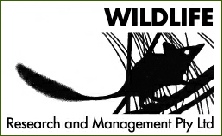Wildlife Research and Management Pty Ltd

The Burrowing Bettong (Bettongia lesueur)
In 1817 the French ship Uranie anchored off Dirk Hartog Island in Shark Bay as part
of its exploration of the west coast of Australia. Its crew collected a specimen
of a small kangaroo unknown to science. It was subsequently described and named after
Charles Le Sueur, the artist and naturalist on a previous French expedition to the
islands in 1802. It became k nown as Lesueur's rat-kangaroo Bettongia lesueur. Today
it is more commonly known as the burrowing bettong or boodie.
nown as Lesueur's rat-kangaroo Bettongia lesueur. Today
it is more commonly known as the burrowing bettong or boodie.
This species is unique among the kangaroos in that it shelters underground in burrows or large communal warren systems. Bettongs are approximately the size of a wild rabbit, are stocky in build and pugnacious in disposition. They are strictly nocturnal, sheltering during the day in burrows and foraging widely at night in search of seeds, fruits, flowers, tubers and roots and succulent leaves and grasses. They will often climb into low shrubs to feed.
Bettongs are capable of producing three young per year in captivity. They have a gestation period of 21 days and give birth to a tiny, unhaired and undeveloped young. Females will then mate again, on the day after the birth and the resulting fertilized egg remains in arrested development in the uterus of the mother until the pouch young is weaned. Pouch life is about 115 days (approximately 4 months). Dominant males establish a harem of females which they defend vigorously against other males. Both sexes have well developed dominance hierarchies.

At the time of the French expedition the burrowing bettong had one of the widest distributions of any species of kangaroo. Its range extended from the western slopes of the Great Dividing Ranges in eastern Australia to the west coast, and from Broome in the tropical north to Albany and Adelaide on the southern coast. Many of the first explorers encountered and commented upon the distinctive warren systems of the bettong. These were characterised by dozens of entrances dug under breaks in surface rock with extensive high mounds of spoil around. Burke and Wills encountered them in southern New South Wales on their south-north crossing of Australia in 1860 as did Giles when crossing the great unexplored deserts of central Australia in the 1870s. These warren systems, now occupied by rabbits, are still recognisable today in many parts of outback Australia.

Shaded area indicates the former distribution of the burrowing bettong
The burrowing bettong now survives only as three remnant populations on off-shore islands: Bernier and Dorre Islands in Shark Bay and Barrow Island off the north-west coast of Western Australia; and recently reintroduced populations at Heirisson Prong and Faure Island in Shark Bay in Western Australia and to a conservation reserve at Roxby Downs in central South Australia. The last burrowing bettong on the mainland was recorded by Europeans at Pingelly in Western Australia's southern wheatbelt in 1942. Information from elderly Aborigines recorded in the 1980s suggest that the bettong may have survived for a further 10 - 20 years in the remote northern deserts of Western Australia.
It is likely that bettongs were eliminated from mainland Australia by a combination
of factors: the alteration of the vegetation understorey by introduced grazers such
as sheep and rabbits; direct competition for food and shelter from rabbits ; predation
from introduced species such as foxes and cats; and changes in land-use practices
to either intensive agriculture in the wetter parts of their range or to grasslands
in central Australia dominated by natural fire regimes rather than ancient fire regimes
imposed by Aborigines.
; predation
from introduced species such as foxes and cats; and changes in land-use practices
to either intensive agriculture in the wetter parts of their range or to grasslands
in central Australia dominated by natural fire regimes rather than ancient fire regimes
imposed by Aborigines.
Between 1988 and 1990 CSIRO conducted surveys of Bernier, Dorre, Barrow, and Boodie Islands to establish the size and stability of populations of endangered mammals. Surveys in 1988 and 1989 revealed a population of some 5,000 bettongs distributed between three islands. Barrow Island (240 square kilometres) contained the greatest number with some 3,500 animals. Subsequent surveys have revealed that these populations fluctuate strongly in size, building up steadily over several years of average to above average rainfall and then crashing in drought.
An ambitious plan to return the burrowing bettong to mainland Australia began in 1992 with the transfer of animals from Dorre Island to Heirisson Prong, a peninsula which juts into Shark Bay. The project was a co-operative venture between the local community of Useless Loop, a mining company Shark Bay Salt Joint Venture, and CSIRO. This group created a fox and cat-free area of some 1200 hectares on Heirisson Prong. This is maintained by a predator-proof fence that runs across the peninsula, a 20 km wide buffer zone of reduced predator density to the south of the fence maintained by poisoning and trapping, and the geography of the peninsula (long and narrow) which limits recolonisation.
In 1999 10 bettongs from the Heirisson Prong project were transferred to the Roxby Downs Arid Recovery Project in central South Australia. They were released into a conservation area of 12 square kilometres and protected by a predator-proof fence. In June 2002 17 bettongs were transferred from Heirisson Prong to Faure Island, in Shark Bay, as part of a non-government conservation effort to restock the island with its original fauna. Australian Wildlife Conservancy manages Faure Island and more than 20 conservation reserves around Australia.
Adapted from Australian Natural History (1992) 24:22-23
The barrier fence that excludes predators from Heirisson Prong
| Project overview |
| Banksia Awards |
| Burrowing bettong |
| Western barred bandicoot |
| Sticknest rats |
| Earthwatch |
| Publications |